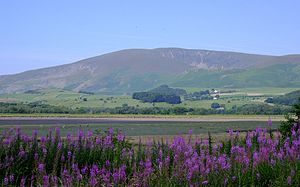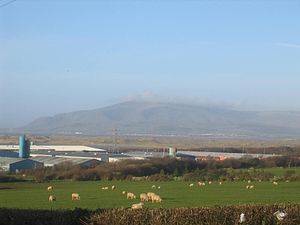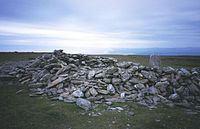Black Combe: Difference between revisions
No edit summary |
|||
| Line 10: | Line 10: | ||
|range=Lake District Outlying Fells | |range=Lake District Outlying Fells | ||
}} | }} | ||
'''Black Combe''' is a fell in the south of [[Cumberland]], north-west of [[Millom]]. The hill is at | '''Black Combe''' is a fell in the south of [[Cumberland]], north-west of [[Millom]]. The hill is at the north-west corner of the [[Lake District]] National Park, where it touches the sea: the summit of Black Combe is just four miles from the [[Irish Sea]]. | ||
Black Combe reaches 1,970 feet at its summit. It stands in isolation, some 10 miles away from any higher ground; this factor offers an excellent all-round panoramic view of land and sea; weather permitting. | Black Combe reaches 1,970 feet at its summit. It stands in isolation, some 10 miles away from any higher ground; this factor offers an excellent all-round panoramic view of land and sea; weather permitting. | ||
| Line 40: | Line 40: | ||
==Routes== | ==Routes== | ||
[[File:Black Combe.jpg|right|thumb|200px|The sprawling cairn on the wide summit of Black Combe]] | [[File:Black Combe.jpg|right|thumb|200px|The sprawling cairn on the wide summit of Black Combe]] | ||
Walks to the top of the fell begin at St Mary's Church, Whicham to the south; St Mary's Church, Whitbeck to the west or from the Corney Fell Road which crosses the fells at an altitude of 1,250 feet four miles to the north of the top. A more challenging and interesting route begins at Beckside Farm on the A595 road and follows Whitecombe Beck before ascending the Horse Back ridge.<ref>Aileen and Brian Evans, ''Short Walks in Lakeland, Book 3'', Cicerone Press, Milnthorpe, | Walks to the top of the fell begin at St Mary's Church, Whicham to the south; St Mary's Church, Whitbeck to the west or from the Corney Fell Road which crosses the fells at an altitude of 1,250 feet four miles to the north of the top. A more challenging and interesting route begins at Beckside Farm on the A595 road and follows Whitecombe Beck before ascending the Horse Back ridge.<ref>Aileen and Brian Evans, ''Short Walks in Lakeland, Book 3'', Cicerone Press, Milnthorpe, Westmorland, 2000, ISBN 1-85284-308-X</ref> This ridge separates Blackcombe and Whitecombe on the eastern side of the fell, and gives good views into both combes. | ||
The summit plateau is a very flat peat-covered area. There is a Triangulation Pillar on the top, surrounded by rough drystone wall which forms a wind shelter. 1,286 feet due south from the peak is a lesser peak upon which stands a large cairn which is easily visible with the naked eye from [[Millom]] and the surrounding area. Between this cairn and the top, in a shallow valley, lies a small tarn. | The summit plateau is a very flat peat-covered area. There is a Triangulation Pillar on the top, surrounded by rough drystone wall which forms a wind shelter. 1,286 feet due south from the peak is a lesser peak upon which stands a large cairn which is easily visible with the naked eye from [[Millom]] and the surrounding area. Between this cairn and the top, in a shallow valley, lies a small tarn. | ||
Latest revision as of 14:23, 16 July 2016
| Black Combe | |||
| Cumberland | |||
|---|---|---|---|
 Black Combe seen across the Duddon Estuary from Foxfield | |||
| Range: | Lake District Outlying Fells | ||
| Summit: | 1,970 feet SD135854 54°15’25"N, 3°19’45"W | ||
Black Combe is a fell in the south of Cumberland, north-west of Millom. The hill is at the north-west corner of the Lake District National Park, where it touches the sea: the summit of Black Combe is just four miles from the Irish Sea.
Black Combe reaches 1,970 feet at its summit. It stands in isolation, some 10 miles away from any higher ground; this factor offers an excellent all-round panoramic view of land and sea; weather permitting.
Subsidiary tops include White Combe, Stoupdale Head, Swinside Fell and Stoneside Hill.[1][2]
The name of the hill is taken from its prominent corrie, dark in colour and itself known as Blackcombe. Adjacent to Blackcombe is a lighter-coloured corrie called Whitecombe.
Views
The view from Black Combe is unique, a result of its isolated position to the south and west of the main Lake District fells. William Wordsworth claimed that "the amplest range of unobstructed prospect may be seen that British ground commands." Half the view is the glittering sea, with the Isle of Man seen clearly to the west, and the hills of Wales and Scotland seen as shadowy silhouettes.[1]
On the seaward side views extend from the Cumberland coast, and from Criffel, 49 miles to the north, an isolated fell on the Kirkcudbrightshire coast near Dumfries, round to the Isle of Man, 45 miles due west, then round to Snowdon which may be seen on days of exceptionally good visibility, 85 miles to the south, and all down the coast of Lancashire. On the landward side; views include the Scafell Group and the Furness Fells, including four 3000-foot mountains: Skiddaw, Scafell, Scafell Pike and Helvellyn. To the east and south the Pennine Hills, the Forest of Bowland and Blackpool Tower are visible. Closer by, there are also good views over the Duddon Estuary, Millom and the new wind farm just offshore.[1][3][4]
Black Combe is easy to sea across Morecambe Bay as the most westerly outlying fell of the Lake District. The name of the Cumberland View public house in Morecambe reflects the view of Black Combe across the bay in Cumberland.

About the hill
Black Combe was one of the five stations in Cumberland used by the Ordnance Survey to measure the angles of Principal Triangles for their initial survey of Britain in the years up to and including 1809. The other stations were Dent ("Dent Hill"), Scilly Banks (on the outskirts of Whitehaven), High Pike and Cross Fell.[5]
The Black Combe Walking Festival takes place annually in June[6] and the Black Combe fell race takes place in early March.[7]
The Swinside, or Sunken Kirk, stone circle is on the eastern flanks of Swinside Fell, in the north east of Black Combe.[8]
Geology
The rocks of Black Combe were formed during the Ordovician period, roughly 460 million years ago. Faulting has exposed an inlier of mudstones from the Skiddaw Group.[9] These rocks, largely mudstones, siltstones and occasional sandstones or greywackes, were formed in deep seas when occasional slides of coastal sediments were redeposited at greater depth.[10]
The nearby Millom Park includes Millom Rock Park, open to the public at all times.[11]
Routes

Walks to the top of the fell begin at St Mary's Church, Whicham to the south; St Mary's Church, Whitbeck to the west or from the Corney Fell Road which crosses the fells at an altitude of 1,250 feet four miles to the north of the top. A more challenging and interesting route begins at Beckside Farm on the A595 road and follows Whitecombe Beck before ascending the Horse Back ridge.[12] This ridge separates Blackcombe and Whitecombe on the eastern side of the fell, and gives good views into both combes.
The summit plateau is a very flat peat-covered area. There is a Triangulation Pillar on the top, surrounded by rough drystone wall which forms a wind shelter. 1,286 feet due south from the peak is a lesser peak upon which stands a large cairn which is easily visible with the naked eye from Millom and the surrounding area. Between this cairn and the top, in a shallow valley, lies a small tarn.
References
- ↑ 1.0 1.1 1.2 A. Wainwright, The Outlying Fells of Lakeland, London: Frances Lincoln 2003 (1974), 2nd edition, revised by Chris Jesty, 2011, ISBN 978-0-7112-3175-7, pages=162–177
- ↑ Database of British and Irish Hills
- ↑ Mark Richards, Lakeland Fellranger, The Southern Fells, Cicerone Press, Milnthorpe, revised edition 2009, ISBN 978-1852845421
- ↑ Panoramic view Retrieved 2 June 2014
- ↑ Lieutenant-Colonel William Mudge, RA FRS and Captain Thomas Colby, RE An Account of the Trigonometrical Survey Carried on by Order of the Master-General of His Majesty's Ordnance in the Years 1800,1801, 1802, 1803, 1804, 1805, 1806, 1807, 1808 and 1809. publ.1811
- ↑ Black Combe Walking Festival
- ↑ Black Combe Fell Race
- ↑ National Monuments Record: No. 37229 – Sunken Kirk
- ↑ British Geological Survey, 1:50,000 geological map - available through the BGS's iGeology smartphone app. Accessed 20th December 2013
- ↑ BGS Lexicon of Named Rock Units: http://bgs.ac.uk/Lexicon - also available through the BGS's iGeology smartphone app. Accessed 20th December 2013
- ↑ Millom Rock Park
- ↑ Aileen and Brian Evans, Short Walks in Lakeland, Book 3, Cicerone Press, Milnthorpe, Westmorland, 2000, ISBN 1-85284-308-X